Finger millet
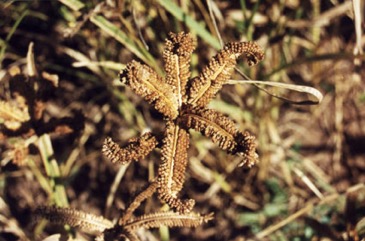
It is a tropical plant. It is a very drought resistant crop. For good yields it needs good soil drainage and adequate moisture. It cannot stand water-logging. It becomes important where rainfall is 900-1250 mm. It especially suits areas with long hot summers. It needs a minimum temperature above 18°C and does best where temperatures are above 27°C. It grows from sea level to 2400 m altitude in Africa. It is a short day length plant and does best where daylength is 12 hours. In Nepal it is grown to about 2500 m altitude. In Kenya it grows from sea level to 2,400 m altitude. It can grow in arid places. In Sichuan and Yunnan.
Also known as:
African millet, Amale, Bavto, Bule, Can, Coracan, Dagussa, Degussa, Gyo-ni, Indian Millet, Kattu kepai, Kayur, Kelvagaru, Kelvaregu, Khakwe, Kodha, Kodo, Kodro, Kremalu, Kurahan, Kurakkan, Kurkan, Lipoko, Long zhao ji, Lupoko, Majolothi, Malesi, Malu, Mandal, Mandua, Marua, Mawe, Mawere, Mijo corocano, Mofoho, Mpogo, Mufhoho, Mulimbi, Murwa, Muttari, Nachani, Nachoni, Nagli, Namarrupe, Natchnee, Mjera, Popoko, Ragi, Ragulu, Rajika, Rapoko, Remaru, Rukweza, Rupoko, Samgorai, Sat-ni, Shina, Tailabon, Tellaboon, Tocusso, Tokuso, Ulezi, Uphoko, Usanje, Wimbi, Ya jiao su, Zviyo, Zvuyo
Synonyms
- Cynosurus coracanus L.
- Eleusine tocussa Fresen.
- Eleusine cerealis Salisb.
- Eleusine luco Welw.
- Eleusine sphaerosperma Stokes
- Eleusine stricta Roxb.
- Eleusine tristachya Kunth.
Edible Portion
- Shoots, Seeds, Cereal, Vegetable
Where does Finger millet grow?
Found in: Afghanistan, Africa, Angola, Asia, Australia, Bangladesh, Bhutan, Botswana, Britain, Burkina Faso, Burundi, Cameroon, Central Africa, Central African Republic, CAR, Chad, China, Comoros, Congo DR, East Africa, Egypt, Eritrea, Eswatini, Ethiopia, Fiji, Ghana, Guam, Himalayas, India, Indochina, Indonesia, Japan, Kenya, Laos, Lesotho, Libya, Madagascar, Malawi, Malaysia, Mali, Mozambique, Myanmar, Namibia, Nepal, Niger, Nigeria, North Africa, Northeastern India, Oman, Pacific, Pakistan, Rwanda, Saudi Arabia, SE Asia, Senegal, Sikkim, Socotra, Somalia, South Africa, Southern Africa, Sri Lanka, Sudan, Swaziland, Taiwan, Tanzania, Thailand, Tibet, Uganda, United Arab Emirates, UAE, West Africa, Yemen, Zambia, Zimbabwe
Notes: There are 9 Eleusine species. They are mostly in tropical Africa. Demo
Status: It is grown on about 1 million hectares in Southern Africa. It is grown on about 3 million hectares in India.
Growing Finger millet
Cultivation: It is grown from seed. Often plants are grown mixed with sorghum or maize. Good soil preparation is needed to reduce weed competition. Seed can be broadcast or drilled. Young plants need to be weeded and thinned. Seed viability drops to about 50 % after 2 years. Spacing of 5 cm apart in rows 30-33 cm apart or 10-12 cm apart in rows 25 cm apart are recommended. About 25-35 kg of seed per hectare are needed if seed are broadcast. 5-10 kg per hectare are required if seed are drilled. Using fertiliser can dramatically increase yield. 125 kg per hectare of sulphate of ammonia when plants are 15 cm high is used in Uganda.
Edible Uses: The seed are eaten either roasted or ground into flour. This is used for porridge and flat bread. Alcohol is brewed from the grain. Caution: Alcohol is a cause of cancer. The leaves are also edible.
Production: It is self pollinating and pollination occurs over 8-10 days. Millet seed stores very well and can be stored without damage for 10 years. Often it is stored on the head. Yields of about 450-900 kg of dried grain per hectare are usual. This can easily be increased to 1650 kg per hectare. Crops take 3-6 months until harvest. Seeds are heated before grinding.
Nutrition Info
per 100g edible portion| Edible Part | Energy (kcal) | Protein (g) | Iron (mg) | Vitamin A (ug) | Vitamin c (mg) | Zinc (mg) | % Water |
|---|---|---|---|---|---|---|---|
| Seeds | 381 | 6.2 | 5.3 | - | - | - | 11.7 |
| Seeds | - | 7.3 | 9.9 | - | - | 1.5 |
Finger millet Photos

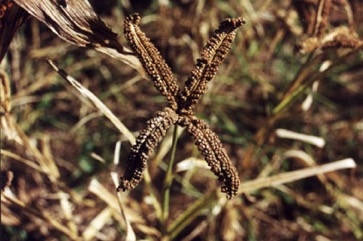
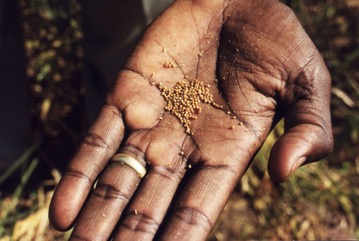
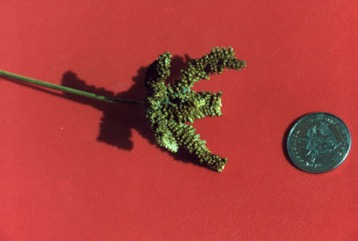
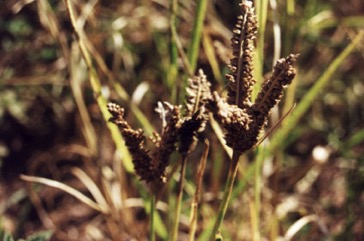
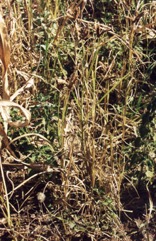
References
Ambasta, S.P. (Ed.), 2000, The Useful Plants of India. CSIR India. p 193
Anderson, E. F., 1993, Plants and people of the Golden Triangle. Dioscorides Press. p 210
Arinathan, V., et al, 2007, Wild edibles used by Palliyars of the western Ghats, Tamil Nadu. Indian Journal of Traditional Knowledge. 6(1) pp 163-168
Brouk, B., 1975, Plants Consumed by Man. Academic Press, London. p 24
Burkill, H. M., 1985, The useful plants of west tropical Africa, Vol. 2. Kew.
Burkill, I.H., 1966, A Dictionary of the Economic Products of the Malay Peninsula. Ministry of Agriculture and Cooperatives, Kuala Lumpur, Malaysia. Vol 1 (A-H) p 930
Chen Shouliang, Lu Shenglian, Wu Zhenlan, et al Poaceae Tribe 19 Eragrostidae Flora of China
de Wet, J.M.J., 2006. Eleusine coracana (L.) Gaertn. [Internet] Record from Protabase. Brink, M. & Belay, G. (Editors). PROTA (Plant Resources of Tropical Africa), Wageningen, Netherlands. < http://database.prota.org/search.htm>. Accessed 15 October 2009.
Facciola, S., 1998, Cornucopia 2: a Source Book of Edible Plants. Kampong Publications, p 175
FAO, 1988, Traditional Food Plants, FAO Food and Nutrition Paper 42. FAO Rome p 264
Flora of Pakistan. www.eFloras.org
Fowler, D. G., 2007, Zambian Plants: Their Vernacular Names and Uses. Kew. p 69
Fox, F. W. & Young, M. E. N., 1982, Food from the Veld. Delta Books. p 294
Fruct. sem. pl. 1:8. 1788
Grubben, G. J. H. and Denton, O. A. (eds), 2004, Plant Resources of Tropical Africa 2. Vegetables. PROTA, Wageningen, Netherlands. p 561
Hedrick, U.P., 1919, (Ed.), Sturtevant's edible plants of the world. p 288 (Also as Eleusine tocussa)
Heywood, V.H., Brummitt, R.K., Culham, A., and Seberg, O., 2007, Flowering Plant Families of the World. Royal Botanical Gardens, Kew. p 394
Hu, Shiu-ying, 2005, Food Plants of China. The Chinese University Press. p 289
Jardin, C., 1970, List of Foods Used In Africa, FAO Nutrition Information Document Series No 2.p 2
Khanal, R., et al, 2014, Documenting abundance and use of underutilized plant species in the mid hill region of Nepal. ECOPRINT 21: 63-71, 2014
Kiple, K.F. & Ornelas, K.C., (eds), 2000, The Cambridge World History of Food. CUP p 115, 1774
Kuo, W. H. J., (Ed.) Taiwan's Ethnobotanical Database (1900-2000), http://tk.agron.ntu.edu.tw/ethnobot/DB1.htm
Lazarides, M. & Hince, B., 1993, Handbook of Economic Plants of Australia, CSIRO. p 89
Li, S., et al, 2020, Monpa, memory, and change: an ethnobotanical study of plant use in Mêdog County, South-east Tibet, China. Journal of Ethnobiology and Ethnomedicine. (2020) 16:5 p 21
Long, C., 2005, Swaziland's Flora - siSwati names and Uses http://www.sntc.org.sz/flora/ (As subsp. africana)
Macmillan, H.F. (Revised Barlow, H.S., et al), 1991, Tropical Planting and Gardening. Sixth edition. Malayan Nature Society. Kuala Lumpur. p 352
Mal, B., S., et al, (Eds), 2010, Minor Millets in South Asia. Bioversity.
Malaisse, F., 1997, Se nourrir en floret claire africaine. Approche ecologique et nutritionnelle. CTA., p 61
Manandhar, N.P., 2002, Plants and People of Nepal. Timber Press. Portland, Oregon. p 215
Martin, F.W. & Ruberte, R.M., 1979, Edible Leaves of the Tropics. Antillian College Press, Mayaguez, Puerto Rico. p 194
Maundu, P. et al, 1999, Traditional Food Plants of Kenya. National Museum of Kenya. 288p
Medhi, P. & Borthakur, S. K., 2012, Phytoresources from North Cachur Hills of Assam -3: Edible plants sold at Hflong market. Indian Journal of Natural Products and Resources. 3(1) pp 84-109
Menninger, E.A., 1977, Edible Nuts of the World. Horticultural Books. Florida p 147
Molla, A., Ethiopian Plant Names. http://www.ethiopic.com/aplants.htm
National Research Council, 1996, Lost Crops of Africa. Volume 1: Grains. National Academy Press, Washington, D.C. p 39
Negi, P. S. & Subramani, S. P., 2015, Wild Edible Plant Genetic Resources for Sustainable Food Security and Livelihood of Kinnaur District, Himachal Pradesh, India, International Journal of Conservation Science. 6 (4): 657-668
Nyadanu, D., et al, 2015, Agro-biodiversity and challenges of on-farm conservation: the case of plant genetic resources of neglected and underutilized crop species in Ghana. Genet. Resourc. Crop Evol. 62(7):
Ochse, J.J. et al, 1931, Vegetables of the Dutch East Indies. Asher reprint. p 311
Paczkowska, G. & Chapman, A.R., 2000, The Western Australian Flora. A Descriptive Catalogue. Western Australian Herbarium. p 103
Peters, C. R., O'Brien, E. M., and Drummond, R.B., 1992, Edible Wild plants of Sub-saharan Africa. Kew. p 22
Plants for a Future database, The Field, Penpol, Lostwithiel, Cornwall, PL22 0NG, UK. http://www.scs.leeds.ac.uk/pfaf/
PROSEA (Plant Resources of South East Asia) handbook Volume 10 Cereals. p 91
Purseglove, J.W., 1972, Tropical Crops. Monocotyledons. Longmans p 146 (Eleusine africana), 147
Purseglove, J.W., 1979, Millets, in Simmonds N.W.,(ed), Crop Plant Evolution. Longmans. London. p 91
Rajapaksha, U., 1998, Traditional Food Plants in Sri Lanka. HARTI, Sri Lanka. p 384
Rashid, H. E., 1977, Geography of Bangladesh. Westview. p 251
Royal Botanic Gardens, Kew (1999). Survey of Economic Plants for Arid and Semi-Arid Lands (SEPASAL) database. Published on the Internet; http://www.rbgkew.org.uk/ceb/sepasal/internet [Accessed 3rd June 2011]
Ruiters-Welcome, A. K., 2019, Food plants of southern Africa. Ph.D. thesis. Univ. of Johannesburg p 87
Shava, S., et al, 2009, Traditional food crops as a source of community resilience in Zimbabwe. International Journal of the African Renaissance 4(1)
Small, E., 2009, Top 100 Food Plants. The world's most important culinary crops. NRC Research Press. p 352
Smith, A.C., 1979, Flora Vitiensis Nova, Lawaii, Kuai, Hawaii, Volume 1 p 305
Solomon, C., 2001, Encyclopedia of Asian Food. New Holland. p 234
Swaziland's Flora Database http://www.sntc.org.sz/flora
Teron, R. & Borthakur, S. K., 2016, Edible Medicines: An Exploration of Medicinal Plants in Dietary Practices of Karbi Tribal Population of Assam, Northeast India. In Mondal, N. & Sen, J.(Ed.) Nutrition and Health among tribal populations of India. p 154
Terra, G.J.A., 1973, Tropical Vegetables. Communication 54e Royal Tropical Institute, Amsterdam, p 45
Tredgold, M.H., 1986, Food Plants of Zimbabwe. Mambo Press. p 24
USDA, ARS, National Genetic Resources Program. Germplasm Resources Information Network - (GRIN). [Online Database] National Germplasm Resources Laboratory, Beltsville, Maryland. Available: www.ars-grin.gov/cgi-bin/npgs/html/econ.pl (10 April 2000)
van Wyk, B., 2005, Food Plants of the World. An illustrated guide. Timber press. p 187
van Wyk, Be, & Gericke, N., 2007, People's plants. A Guide to Useful Plants of Southern Africa. Briza. p 10
van Wyk, B-E., 2011, The potential of South African plants in the development of new food and beverage products. South African Journal of Botany 77 (2011) 857–868
Vickery, M.L. and Vickery, B., 1979, Plant Products of Tropical Africa, Macmillan. p 10
Wehmeyer, A. S, 1986, Edible Wild Plants of Southern Africa. Data on the Nutrient Contents of over 300 species
Williamson, J., 2005, Useful Plants of Malawi. 3rd. Edition. Mdadzi Book Trust. p 105
Wilson, J.M. & Witcombe, J.R., Crops for Arid lands, in Wickens, G.E., Goodin, J.R., and Field, D.V.,(Eds.) 1985, Plants for Arid Lands. Unwin Hyman, London, p 39
World Checklist of Useful Plant Species 2020. Royal Botanic Gardens, Kew
www.zimbabweflora.co.zw 2011